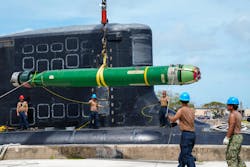Navy asks Lockheed Martin to replenish stocks of MK 48 heavyweight torpedo with sonar and wire guidance
Summary points:
- $245.4 million contract awarded to Lockheed Martin for production, spares and repair of the MK 48 Mod 7 heavyweight submarine torpedo.
- CBASS broadband upgrade improves shallow-water and deep-water performance with multiband active/passive sonar, advanced counter-countermeasures and modular COTS-based electronics.
- Supports U.S. Navy, Australia, and other partners; work in New York, Florida, and Massachusetts, with completion expected by September 2027.
WASHINGTON – U.S. Navy undersea warfare experts are asking Lockheed Martin Corp. to build and support the submarine-launched MK 48 heavyweight torpedo under terms of a $245.4 million contract announced on Tuesday.
Officials of the Naval Sea Systems Command in Washington, are asking the Lockheed Martin Rotary and Mission Systems segment in Liverpool, N.Y., for production, spares parts, and repair of the MK 48 MOD 7 heavyweight torpedo.
The MK 48 torpedo is standard armament for the Navy's fleet of Los Angeles-, Virginia-, and Seawolf-class fast attack submarines, as well as Ohio-class ballistic- and cruise-missile submarines. The torpedo also is for Australian Collins-class attack submarines, and Taiwanese submarines. This contract involves torpedoes for the U.S. Navy, the Royal Australian Navy, and other U.S. allies.
The MK 48 torpedo is 19 feet long, 21 inches in diameter, and weighs 3,500 pounds. It can hunt enemy submarines at depths to 1,200 feet at distances as far as five miles. The torpedo can travel as fast as 28 knots and has a 650-pound high-explosive warhead.
Primary submarine weapon
The much-upgraded MK 48 torpedo has been in service since 1972, and is the U.S. Navy's primary submarine weapon for use against enemy submarines and surface ships.
The MK 48 and its improved Advanced Capability (ADCAP) torpedoes can be guided from a submarine by wires attached to the torpedo. They also can use their own active pinging sonar or passive listening sonar to carry out programmed target search, acquisition, and attack procedures.
The torpedo is designed to detonate under the keel of a surface ship to break the keel and sink the ship quickly. After a miss, the torpedo can circle back for another attempt. The torpedo's seeker has an active electronically steered 2D phased array active sonar.
The latest version of the MK 48 is the MK 48 Mod 7 Common Broadband Advanced Sonar System (CBASS) with expanded operational capabilities for shallow waters along coastlines and inside harbors, as well as in the deep-water open ocean.
MK 48 Mod 7
The CBASS broadband sonar enhancement makes the torpedo more effective against new enemy submarines that deploy noise makers. It uses modern commercial-off-the-shelf (COTS) technologies in an open-architecture computing environment, and can be improved with regular hardware and software upgrades.
The MK 48 Mod 7 CBASS kit’s evolutionary design and modular nature makes the upgrade of older version MK 48 torpedoes to the Mod 7 CBASS capability a relatively straightforward effort without requiring significant torpedo redesign and certification.
The electronic subsystems of the MK 48 MOD 7 torpedo include an advanced sonar receiver, and provides multiband sonar with both active and passive homing, advanced counter-countermeasures, and are for deep and shallow waters.
The broadband sonar system uses an active electronically steered 2D phased array active sonar seeker, while the torpedo's guidance and control sections interface with propulsion, inertial measurement units, depth sensors, and warhead electronics.
Torpedo electronics
Signal processors handle classification, target tracking, and tactical decision-making, while warhead electronic assemblies include target-detection electronics with contact and proximity functions. Software for tactical processing is uploaded before launch and is erased after use to maintain security.
The CBASS torpedo also has multiband operation with active and passive homing; advanced counter-countermeasures; effectiveness against low-Doppler shallow submarines, fast deep diving submarines, and high-performance surface ships; autonomous fire-and-forget operation or wire-guide capability to enable post-launch monitoring and updates via the submarine combat system; and running Otto Fuel II as the propellant.
The MK 48 Mod 7 CBASS provides the ability to transmit and receive over a wide frequency band and use broadband signal processing techniques to improve the torpedo’s search, acquisition, and attack effectiveness.
On this contract Lockheed Martin will do the work in Liverpool, N.Y.; Clearwater, Fla.; and in Braintree, Mass.; and should be finished by September 2027. For more information contact Lockheed Martin Rotary and Mission Systems online at https://www.lockheedmartin.com/en-us/news/features/2025/5-fast-facts-about-the-mk-48-heavyweight-torpedo.html, or Naval Sea Systems Command at www.navsea.navy.mil.
About the Author
John Keller
Editor-in-Chief
John Keller is the Editor-in-Chief, Military & Aerospace Electronics Magazine--provides extensive coverage and analysis of enabling electronics and optoelectronic technologies in military, space and commercial aviation applications. John has been a member of the Military & Aerospace Electronics staff since 1989 and chief editor since 1995.
